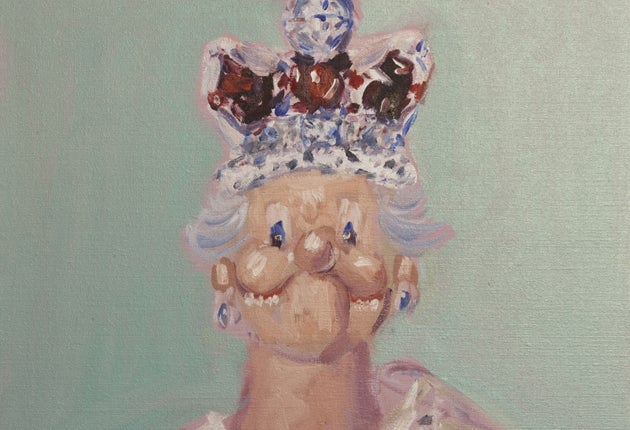The comedy of horror
George Condo's unsettling paintings have often been controversial, but two new exhibitions show his work's profundity. By Arifa Akbar

Hip-hop legend has it that Kanye West hoped to make the cover of his last album so street-cool that it would at the very least offend, and at best, get banned.
To that end, he called on George Condo, an artist with a track record for dismantling cultural icons – God, Jesus and the Queen among them – with a dark, disfiguring, comic savagery.
Condo did not disappoint, offering West a pick of startling images – a portrait of the singer with four sets of teeth, another with his head decapitated and impaled by a sword, and a lurid scene of a naked black man being straddled by a white phoenix-like creature.
West went with the last image for the cover of My Beautiful Dark Twisted Fantasy and it was duly banned by certain US retailers whose sensibilities were offended by its graphic bestiality.
It was not the first time Condo's work had unsettled. His oeuvre exudes a profound and compelling oddness that has sometimes been mistaken for attention-seeking profanity and insolence.
Three decades after launching his career with a series of fake Old Masters that seemed to mock the artistic canon, he has combined European historical portraiture with American caricature to present old and modern-day heroes in an unheroic light.
His iconoclasm has earned him a starry following: The Chapman Brothers, Fiona Rae and Glenn Brown; Salman Rushdie who created a character in Fury based on a Condo portrait; even the Olsen Twins and Patti Smith.
Two exhibitions next month will appraise Condo's achievements, and reflect on the popular misconception that he is merely sending-up his parade of tragic-comic subjects. The Hayward Gallery will showcase his most important portraits and sculptures in Mental States, which reflect his desire to explore the "outer suburbs of acceptability", while Sprueth Magers gallery will focus on his drawings.
Born in 1957 in New Hampshire, the artist moved to New York and quickly claimed a place in the thriving arts scene of the city in the 1980s, befriending Keith Haring and Basquiat, William Burroughs as well as the beat poets, Jack Kerouac among them.
But while Haring and Basquiat were building a tradition of pop and street art, Condo went against the zeitgeist of the East Village arts scene to focus on the work of the Old Masters.
After some time in New York, Condo left for Paris where he spent time absorbing the tradition of painting by pitching up at the Louvre for hours on end to copy the Raphaels.
"It brought me back to painting," he said years later, "which wasn't fashionable at the time."
Ralph Rugoff, director of the Hayward Gallery and curator of this show, explains that the art-historical references in his work that have earned him a reputation as "the artist's artist" are part-reappraisal, part-homage, though they may on the face of it be read as a savage kind of comic replication.
Condo developed a quirky line of "fake Old Master" portraits that combined stylistic elements borrowed from several different artists, including Velázquez, Rembrandt and Goya.
In the 1990s, he developed a freakish kind of pictorial species that he labelled "antipodes", pin-headed beings that summed up the different, sometimes unnameable states of human consciousness. Condo has suggested in past interviews that he seeks to capture a kind of psychological Cubism, an expression that "that reflects simultaneous emotions or conversations with the conflicting voices in your head".
Controversially, he began drawing on religious figures using these "antipodes" – a 2002 portrait of Jesus shows him boggle-eyed and shabby, like a "refugee from a rehab clinic for steroid abusers", reflects Rugoff.
"Above the puckered topography of his bulbous nose and cheeks, a pair of vertical eyes convey a look of cartoon alarm, as if he were not quite sure how he landed in this catastrophe of a face."
There is also a kitschy portrait of God, his arms in spread open on an invisible cross, surrounded by a cloud of celestial light, which appears deliberately tawdry and cartoonish.
When, in 2006, he was commissioned to produce a portrait of Queen Elizabeth to hang at Tate Modern, he ended up making a series of 10, because of his belief that a single portrait cannot hope to capture the totality of a person.
They were given arch titles (Blonde Queen, Metaphysical Queen, Comic Queen, Pop Queen, The Mad Queen) and showed her face in incarnations ranging from demure to garish, surreal and sinister, with over-blown cheeks, carrots in her ears, and the large red rictus-grin of a circus clown.
Rugoff explains that Condo's task is more nuanced than an exercise in punkish irreverence: "It's not just a sending-up. He is doing something secular with our icons; he's not treating them as if they are holier and transcendent and above being human. He is treating them as being immensely, fully human."
The unsettling effect is very much a deliberate ploy in the artist's work. It is designed to self-consciously disarm the viewer's expectations.
As Condo himself says, "I like people to walk into one of my exhibitions and say, 'What happened?'"
George Condo: Mental States, Hayward Gallery, London SE1 (020 7960 4200) 18 October to 8 January 2012. Drawings by George Condo, Sprueth Magers, London W1 (020 7408 1613) 11 Octoberto 12 November 2011
Subscribe to Independent Premium to bookmark this article
Want to bookmark your favourite articles and stories to read or reference later? Start your Independent Premium subscription today.

Join our commenting forum
Join thought-provoking conversations, follow other Independent readers and see their replies